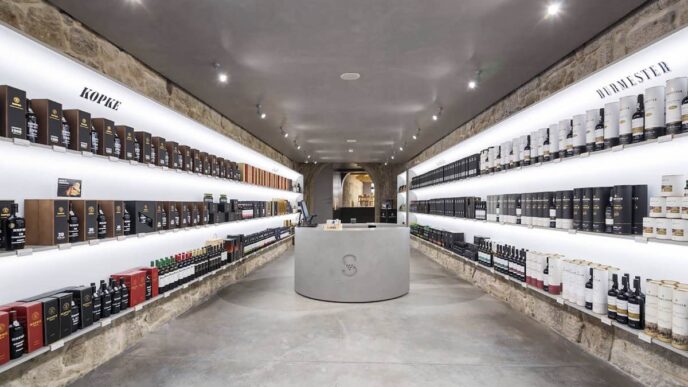Tawny port wine, a staple of Portuguese winemaking, is a delightful treat for wine lovers around the globe. Its unique aging process, rich history, and versatile pairings make it a favorite among connoisseurs and casual drinkers alike. Whether you’re exploring its diverse varietals or discovering the perfect food pairing, tawny port offers a journey through taste and tradition that’s hard to resist.
Key Facts
- Tawny port wine is known for its rich flavors and unique aging process.
- There are several types of tawny port, each offering a different taste experience.
- Pairing tawny port with food enhances its flavors and provides a delightful culinary experience.
- Proper serving techniques can elevate the enjoyment of tawny port wine.
- Tawny port has a storied history, originating from the Douro Valley in Portugal.
The Alluring World of Tawny Port Wine
Understanding Tawny Port’s Unique Characteristics
Tawny Port is like the warm glow of a sunset captured in a bottle. Unlike its Ruby counterpart, Tawny Port undergoes a unique aging process in small oak barrels, which gives it a distinctive amber hue and a complex flavor profile. This aging allows the wine to develop nutty, caramel, and dried fruit notes, making each sip a journey through time. It’s a wine that whispers tales of its past, with every glass offering a taste of its rich heritage.
The Aging Process: From Barrel to Bottle
The journey of Tawny Port from barrel to bottle is a fascinating one. Initially, the wine is fortified with grape spirit, which halts fermentation and preserves its natural sweetness. It then spends years aging in oak barrels, where it undergoes a slow transformation. This process, known as oxidative aging, allows the wine to interact with oxygen, enhancing its flavors and deepening its color. The result is a wine that is both robust and refined, with a complexity that only time can bestow.
Tawny Port’s Distinctive Flavor Profile
Tawny Port’s flavor profile is a tapestry of tastes woven together over time. The wine’s hallmark is its balance of sweetness and subtlety, with flavors ranging from ripe figs and dates to toasted almonds and spices. As it ages, Tawny Port develops additional layers, revealing hints of honey, vanilla, and even a touch of smokiness. This complexity makes it a versatile choice, perfect for sipping on its own or pairing with a variety of foods. For those who appreciate a wine with depth and character, Tawny Port offers an unforgettable experience.
Tawny Port is not just a drink; it’s a testament to the artistry of winemaking, where time and tradition intertwine to create something truly special.
Exploring Tawny Port Varietals
Basic Tawny: A Versatile Choice
Basic Tawny Port is like that trusty old sweater you pull out on a chilly day. It’s comfortable, familiar, and always hits the spot. This type of Tawny is typically aged for about three years, giving it a lighter, more approachable character. It’s got a nice balance of fruity notes with just a hint of oak, making it a great choice for an aperitif. If you’re new to Tawny Port, starting with a Basic Tawny is a great way to dip your toes into the world of fortified wines.
Tawny Reserve: A Step Above
When you’re ready to take it up a notch, Tawny Reserve is where you go. This isn’t your average Tawny. It spends more time in the barrel, which means it develops more depth and complexity. You’ll notice a richer mouthfeel and flavors that pair beautifully with nuts and creamy desserts. Think of Tawny Reserve as the more sophisticated cousin of Basic Tawny, perfect for those moments when you want something a little more special.
Aged Tawny: The Pinnacle of Complexity
Now, if you’re really looking to treat yourself, aged Tawny is where it’s at. These are labeled with their age—10, 20, 30, or even 40 years—and each decade adds layers of flavor. Imagine sipping on something that tastes like dried fruit, nuts, and spice all rolled into one. Aged Tawny is like liquid history, and every sip tells a story. Whether you’re celebrating a milestone or just want to savor something truly exceptional, aged Tawny is the way to go.
The beauty of Tawny Port lies in its ability to evolve over time, offering a taste experience that’s as rich and varied as the years it’s aged. Whether you’re a newcomer or a seasoned enthusiast, there’s a Tawny Port out there that’s just right for you.
Perfect Pairings with Tawny Port Wine
Cheese Pairings: A Classic Combination
Tawny Port and cheese is like a match made in heaven. The nutty, caramel notes of Tawny Port beautifully complement hard, aged cheeses like Manchego and Parmigiano-Reggiano. The richness of the cheese draws out the complex flavors of the port, creating a luxurious tasting experience. For a more adventurous pairing, try it with a sharp blue cheese, where the port’s sweetness balances the cheese’s pungent tang.
Dessert Pairings: Sweet Harmony
When it comes to desserts, Tawny Port is a versatile companion. Its hints of dried fruit and caramel make it an excellent choice for pairing with almond biscotti or crème brûlée. The wine’s depth matches the intricate flavors of these desserts, turning each bite into a symphony of taste. For a more indulgent treat, pair a rich chocolate tart with a 20-year Tawny Port, where the berry notes in the port elevate the chocolate’s decadence.
Main Course Pairings: A Bold Choice
You might not think of Tawny Port as a partner for main courses, but it can be a bold and exciting choice. Consider using it in a port reduction sauce for a seared duck breast. The concentrated flavors of the port add a new dimension to the dish, while the duck’s fattiness balances the wine’s sweetness. For something different, serve White Port as an aperitif to cleanse the palate before diving into the main course. Its crisp nature prepares you for the flavors to come.
Discovering the perfect pairing of Tawny Port with food is like finding a hidden treasure, where each sip and bite enhance one another, creating an unforgettable experience.
The Art of Serving Tawny Port Wine
Proper Glassware for Tawny Port
When it comes to serving Tawny Port, choosing the right glassware can make a big difference. Forget those chunky goblets; instead, go for something that really lets the wine shine. A tulip-shaped glass is ideal, as it helps to focus the aromas towards your nose, enhancing the tasting experience. While fine crystal glasses feel luxurious, clear glass is perfectly fine and lets you appreciate the rich amber hues of the Tawny.
Ideal Serving Temperature
Temperature is key to bringing out the best in Tawny Port. Unlike some other ports, Tawny Port should be served slightly cooler. Aim for a temperature between 55°F and 62°F. This range allows the wine to express its delicate, nuanced flavors without losing its charm. Serving Tawny Port just below room temperature enhances its sweetness and rich flavors, making it a delightful companion to your meal.
Decanting Tawny Port: When and Why
Decanting Tawny Port isn’t always necessary, but it can be beneficial, especially for older bottles. If you’re dealing with an aged Tawny, letting it breathe can enhance its complex flavors. Here’s a simple guide to decanting:
- Preparation: Stand the bottle upright for at least 24 hours to let any sediment settle.
- Pouring: Use a decanter, and pour slowly with the bottle neck against a light source. Stop pouring when you see sediment approaching the neck.
- Enjoy: Once decanted, let the wine sit for a bit before serving to allow the flavors to fully open up.
Serving Tawny Port is more than just pouring a glass; it’s about creating an experience that highlights the wine’s unique character. Whether you’re enjoying it with a meal or as a standalone treat, the right serving techniques can truly elevate your enjoyment.
The Rich History of Tawny Port Wine
Origins in the Douro Valley
Tawny Port’s roots are deeply embedded in the Douro Valley, a region in Portugal known for its steep, terraced vineyards and robust winemaking tradition. For centuries, this valley has been the cradle of Port wine, with its unique microclimate and schistous soil providing the perfect conditions for growing the indigenous grape varieties used in Tawny Port. The history of Tawny Port is intertwined with the valley’s cultural and economic development, marking it as a significant player in the region’s identity.
Evolution of Tawny Port Over the Centuries
The evolution of Tawny Port over the centuries is a tale of innovation and adaptation. Initially, Port wine was shipped in barrels to England where it would often spoil. To prevent this, winemakers began fortifying the wine with brandy, resulting in the sweet and robust drink we know today. As time went on, the aging process was refined, allowing for the development of the Tawny Port’s signature flavor profile—rich in dried fruits, nuts, and spices. The introduction of age-indicated Tawnies (10, 20, 30, 40 years) further enriched its complexity, offering a glimpse into the past with each sip.
Famous Tawny Port Houses
Several renowned port houses have played pivotal roles in the history and prestige of Tawny Port. Names like Taylor Fladgate, Graham’s, and Fonseca are synonymous with quality and tradition. These houses, along with boutique producers like Quinta do Noval and Quevedo, have mastered the art of Tawny Port production, balancing innovation with time-honored techniques. Their contributions have not only shaped the landscape of Tawny Port but have also cemented its status as a symbol of Portuguese craftsmanship and heritage.
Tawny Port Wine in Culinary Delights
Using Tawny Port in Cooking
Tawny Port is not just for sipping; it can transform dishes into something extraordinary. Imagine deglazing a pan of roast venison with Tawny Port. The wine’s rich, nutty flavors meld with the caramelized bits of meat and herbs, creating a sauce that’s nothing short of magical. It’s also great for marinades, adding depth and a hint of sweetness to meats like pork or duck.
Creating Sauces with Tawny Port
Creating sauces with Tawny Port is like crafting a masterpiece. Start by reducing the port with shallots and garlic, then add a splash of cream for a velvety finish. This sauce pairs beautifully with beef or lamb, bringing out the savory notes of the meat while adding a luxurious touch.
Tawny Port in Desserts
Desserts take on a new dimension with Tawny Port. Try poaching pears in the wine for a simple yet elegant dessert. The fruit absorbs the port, turning a basic dish into a jewel-like creation with layers of flavor. You can also use Tawny Port in chocolate desserts, where its caramel and nutty notes enhance the richness of the chocolate, creating a harmonious blend of flavors.
Tawny Port’s versatility in the kitchen is truly impressive. From savory dishes to sweet treats, this wine brings a unique depth and complexity that elevates every culinary creation.
Understanding Tawny Port Wine Regulations
Grape Varieties Approved for Tawny Port
When it comes to Tawny Port, only specific grape varieties are allowed. These include Touriga Nacional, Tinta Roriz, and Touriga Franca, among others. The selection is strict, ensuring only the best grapes contribute to this iconic wine.
Aging Requirements and Standards
Aging is crucial in defining the character of Tawny Port. The wine must meet strict aging requirements, with some varieties spending decades in oak barrels. This process is what gives Tawny Port its distinctive nutty and caramel flavors.
Labeling and Certification Processes
Every bottle of Tawny Port undergoes a rigorous certification process. The Instituto dos Vinhos do Douro e do Porto (IVDP) oversees this, ensuring that each bottle meets high standards. Labels like ’10-year-old Tawny’ truly reflect the wine’s age, thanks to this stringent oversight.
The IVDP acts as the guardian of Port wine, preserving its tradition while ensuring quality and authenticity. This meticulous process guarantees that every sip of Tawny Port is a taste of its rich heritage.
Conclusion
So, there you have it. Tawny Port isn’t just a drink; it’s an experience, a journey through flavors and time. Whether you’re pairing it with a sharp cheese or a sweet dessert, each sip tells a story of tradition and craftsmanship. It’s like having a piece of history in your glass, something to savor and share. Next time you find yourself with a bottle of Tawny Port, take a moment to appreciate the rich tapestry of flavors and the dedication that goes into every drop. Cheers to discovering new favorites and enjoying the simple pleasures in life!
Frequently Asked Questions
What is the best way to serve Tawny Port wine?
Tawny Port is best served slightly chilled in a small glass to appreciate its rich flavors. It can be enjoyed as an aperitif or with desserts.
How long can I keep an opened bottle of Tawny Port?
Once opened, Tawny Port can last up to a month if stored in a cool, dark place with the cork tightly sealed.
What foods pair well with Tawny Port?
Tawny Port pairs wonderfully with hard cheeses like Parmesan, as well as desserts such as almond biscotti and crème brûlée.
What makes Tawny Port different from other Port wines?
Tawny Port is aged in wooden barrels, which gives it a nutty, caramel flavor and a lighter color compared to other Ports like Ruby.
Can Tawny Port be used in cooking?
Yes, Tawny Port can add depth to sauces and desserts, enhancing flavors with its sweet, nutty notes.
Is Tawny Port suitable for vegans?
Most Tawny Ports are vegan-friendly, but it’s always a good idea to check the label or contact the producer to be sure.













